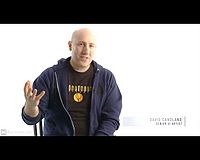David Candland: Difference between revisions
From Halopedia, the Halo wiki
(Minor corrections specifically about how David Candland got interested in video games.) Tag: Reverted |
(David "was employed by ... from 2000-2018.") |
||
| (One intermediate revision by one other user not shown) | |||
| Line 2: | Line 2: | ||
[[File:DavidCandland.jpg|thumb]] | [[File:DavidCandland.jpg|thumb]] | ||
'''David Candland''', often nicknamed '''Evil Otto''' | '''David Candland''', often nicknamed '''Evil Otto''' is an interface designer and artist for video games. He was employed by [[Bungie|Bungie Studios]] from 2000-2018. Born in 1971 and raised in Seattle, Washington, his first job was working for [[Microsoft]] as a 3D Movie Maker and art intern. He first gained interest in video games through the ''[[Marathon]]'' video game series, and after a great deal of work, he now works for [[Bungie]]. He has been married for over 13 years to his wife, Marcy. He has six children, one of whom is named Rylee and another named Dallin . His entire family was featured on the [[Halo 3 Collector's Edition|Collector's Edition]] and [[Halo 3 Legendary Edition|Legendary Edition]] of ''[[Halo 3]]'', where [[Chris Butcher]] showed how and how not to set up a home network. David Candland is a Mormon and lives near Seattle, Washington. | ||
He was [[credits|credited]] as a | He was [[credits|credited]] as a user interface designer for ''[[Halo: Combat Evolved]]'',<ref>'''[[Halo: Combat Evolved]]''' [[Halo: Combat Evolved credits|credits]]</ref> and then user interface artist and user interface designer for ''[[Halo 2]]''.<ref>'''[[Halo 2]]''' [[Halo 2 credits|credits]]</ref> As a result of his job role, he is referenced in an in-game [[DAVE Easter egg|easter egg]] hidden in the [[Heads-Up Display]]. | ||
==Trivia== | ==Trivia== | ||
Latest revision as of 23:51, July 7, 2024
David Candland, often nicknamed Evil Otto is an interface designer and artist for video games. He was employed by Bungie Studios from 2000-2018. Born in 1971 and raised in Seattle, Washington, his first job was working for Microsoft as a 3D Movie Maker and art intern. He first gained interest in video games through the Marathon video game series, and after a great deal of work, he now works for Bungie. He has been married for over 13 years to his wife, Marcy. He has six children, one of whom is named Rylee and another named Dallin . His entire family was featured on the Collector's Edition and Legendary Edition of Halo 3, where Chris Butcher showed how and how not to set up a home network. David Candland is a Mormon and lives near Seattle, Washington.
He was credited as a user interface designer for Halo: Combat Evolved,[1] and then user interface artist and user interface designer for Halo 2.[2] As a result of his job role, he is referenced in an in-game easter egg hidden in the Heads-Up Display.
Trivia[edit]
Candland has been featured three times on Rooster Teeth's weekly series Fails of the Weak showcasing Halo fails, first when he splattered himself into a wall in the middle of a lunge, the second time when the driver of his Warthog failed to make a turn and drove into the water, and the third time when he was killed by a grenade to the crotch. He is currently the only known Bungie employee to have been featured.
